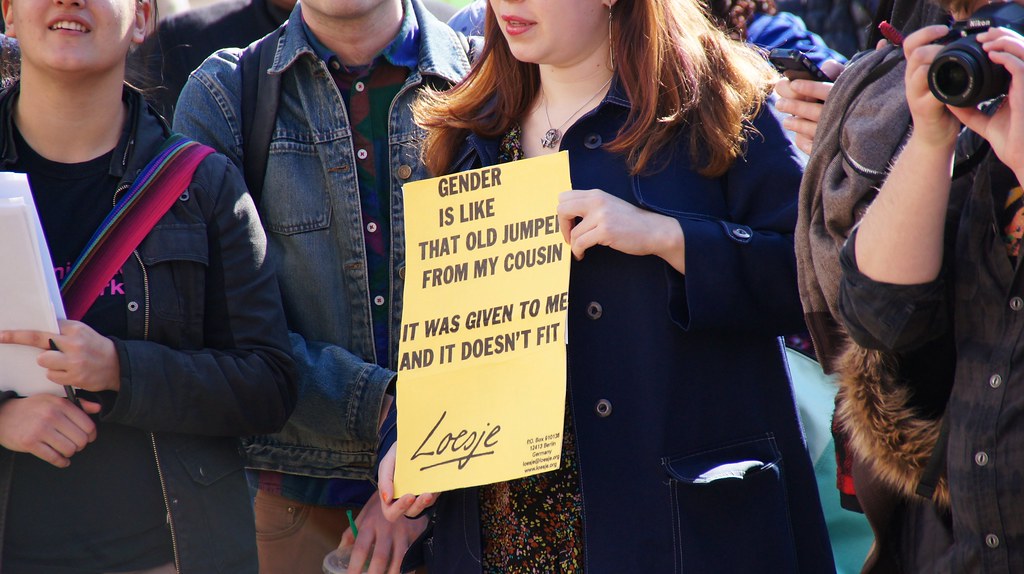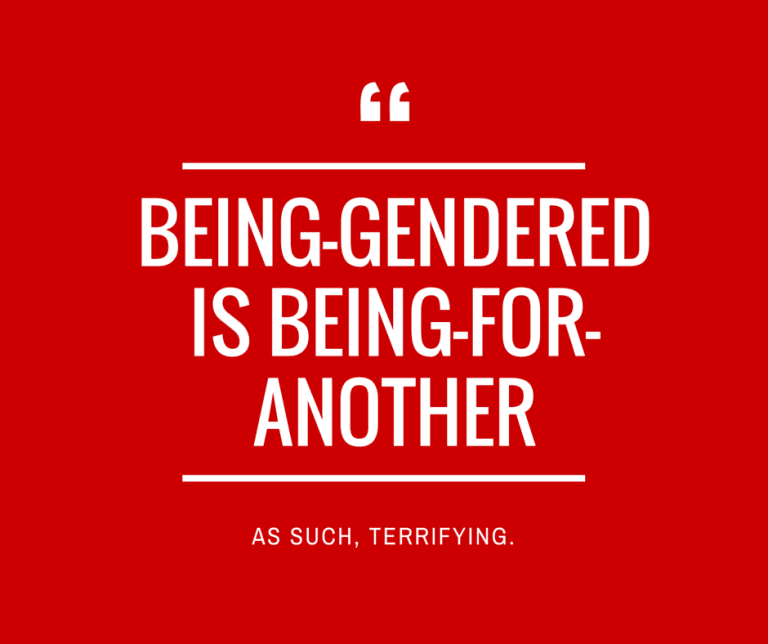
Transgenderism, postgenderism and any other non-binary systems of understanding gender tend to rely on the definition of “gender identity” as an “innermost concept of oneself as male, female, a blend of both or neither” (Human Rights Campaign) or “a person’s internal, deeply held sense of their gender” (GLAAD). While not all views can be fit into this “official” schema, they represent the go-to description of the transgendered persons I speak with. Sure, some hold gender to be “nothing more than a social construct” and others nothing more than an oddity of “biology,” but when it comes to self-identification, they all look to an “inner sense” by which they measure their various gender-identity options and declare them fitting or ill-fitting.
Such views, then, usually place this “innermost concept” at a hierarchical peak. It reigns over any and all other data we may use to describe gender. It has “veto power” over anatomy, genetic makeup, and the lived-body experience. It is prioritized over any religious interpretation, communal interpretation, or familial interpretation of the body. Whatever else goes into “gender,” this “innermost concept” has the final say. To deny its supremacy in terms of our own gender would be an inauthentic refusal to listen to that “still, small voice.” To deny its supremacy in terms of another person’s gender would be a violence against them. To assert some other data — “but you are my husband,” “but I can give birth,” “but you have this or that brain structure” — all this is inadequate. Psychological self-experience trumps.
It would be useless to suggest that this rise of self-concept over any other forms of “gender-data” is a situation that only applies to “non-binary” persons. One could not argue that “psychological self-experience is the supreme form of determining gender for certain people” without raising the rather obvious question — what if those certain people are wrong? And if they can be wrong, it hardly provides a strong basis for the practical, civil rights claims of the movement. To the demand for equal access to a locker room, an opponent could simply say, “Look, you hold that gender identity is the supreme form of establishing objective gender. I do not. I happen to be a person who holds that the physical body is the supreme form of establishing objective gender.” To avoid this awkward impasse, one must argue “gender identity is the supreme data by which the human person determines gender — for you, for me, and for everyone in between. You cannot simply disagree and thus bar me from accessing your gender-exclusive location. I am right and you are wrong. You must act, not according to any other gender-data, but according to my personal self-concept.”
Insofar as any person agrees with the civil rights claims of transgender persons, they are implicitly agreeing with a theory of gender which grounds these claims. It is, after all, only this theory that makes these claims more than arbitrary wishes. Only if it is really true that gender is a primarily psychological phenomenon are transgender persons justified in claiming access to gendered institutions on the basis of psychological self-experience.
Is It Just About Rights?
But here I doubt the claim that the transgender “only” demands the respect due to the humanity of transgender persons. It is true that no one in the transgender movement “demands that anyone become trans” but they do demand that everyone become quite different.
If I have a daughter (and have up to this point considered her as daughter, not because I know her mental self-affirmation of gender-identity, but because she was given to me as “my daughter,” named by her mother, held as female by a tradition I trust, given over to a menstrual cycle, and so forth) I must now consider her as “my daughter” based entirely on a principle of which I can have no certainty — her private self-experience. I must become uncertain as to whether she is my daughter — only repeated verbal affirmations of her hidden mental state could affirm this as a fact. I must consider her communal body (the way she looks and speaks) her history (how she was raised, how she was given the language and lessons of identity) and the network of relations she is embedded in (as sister, granddaughter, and so forth) as extrinsic and ultimately unimportant. She has the good luck to have a mind that, by the age of 6 or 7, coheres with the rest of her being. If her mind changes, my daughter will become a son. To accept this means holding the current identity of “daughter” in flux. It is no longer a permanent relation. Plainly speaking, no person can ever have a son or a daughter, only a daughter-for-now or a son-for-now. Even if, at 8, she reveals that she “identifies as a man,” requests the pronoun “he,” and begins the process of transitioning, there is no good reason to assume that my now “son” will not self-identify as my “daughter” once more. My point is not that such “coming outs” should not be met with respect — they may be the correct response to the true nature of gender. My point is that it is foolish to pretend that the gaze which sees a daughter and the gaze which sees a daughter-for-now are the same. They are not.
This view of having a daughter-for-now is not something that “kicks in” if my daughter identifies as a man. It is the first view I must adopt when I see her as a being gendered in and through her own psychological self-experience. To do otherwise is simply not to take the “innermost concept” claim as true. I may pay it lip-service, perhaps, in reference to “those people,” but I do not to take it as a proposition actually effects me — a unique view of gender which restructures how I see every human person. But if I do not take it as true, how can I simultaneously agree with the civil rights claims of transgender persons which rely on the truth of the proposition in order to be taken seriously?
In fact, if I am to remain consistent, I must consider no gendered relationship as permanent or fundamental or intrinsic — only contingent and changeable. I must consider no body — neither my own, nor my wife’s nor my child’s nor my father’s — as an expression of the truth about the person. It is always possible that the body of my loved one will turn out to be the “wrong” body. I must hold it in suspense. I must detach myself from it. I must love a body without communal interpretation, a neutral, uninterpreted, material X that exists prior to any thought of being-man, being-woman, being-neither, being-both. The body gives no truth. Every body — from the perspective of the supremacy of self-concept over all other gender-data — is a possibly-wrong body.
To look on a loved body as a possibly-wrong body is, quite simply, a radically different way of looking. This may be an accurate or inaccurate description of the embodied person — only a rigorous philosophical argument can determine that. This much, however, is certain — the non-binary position cannot be held to be held to be the position of an oppressed minority group that has no effect on other groups. It is either an initiation into a world of daughters-for-now and possibly-wrong bodies or it is not being taken seriously.










